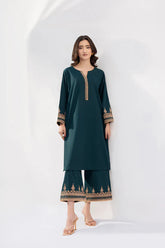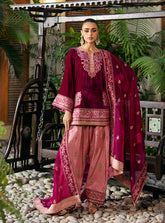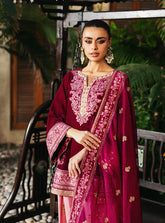Bridal Dress in Pakistan: Explore Astounding Pakistani Bridal Dresses
Pakistani bridal attire serves as a vibrant reflection of the nation's rich cultural traditions. Bridal dresses are renowned for their intricate designs, luxurious fabrics, and vibrant colors, symbolizing elegance and tradition.
The traditions surrounding bridal dress in Pakistan demonstrate the tapestry of Pakistani culture. Ranging from heavier embroideries like zardozi to lighter works like gota, the meticulous needlecraft featured in bridal dresses link to regional histories.
Materials also vary locally - from breathable cottons in Sindh to woven silks in Punjab. Cultural blending further diversifies bridal style, with influences from neighboring regions. Craftspeople dedicate themselves to this art, imparting unique regional techniques across generations. Their skillful creations showcase Pakistan's dynamic cultural heritage through bridal couture.
The Diversity of Pakistani Bridal Dresses
Bridal dress in pakistan showcase a remarkable diversity influenced by the country's various regions and cultural amalgamation. The most iconic among them are:
1. Lehenga Choli:
A Lehenga Choli is often selected for bridal dress in Pakistan seeking to honor tradition with their attire. This ensemble incorporates three key pieces - a full, flared skirt called a Lehenga, a form-fitting blouse known as a Choli, and a flowing dupatta scarf.
Where intricate embroidery, sequins, and zari work embellish the Lehenga Choli, a stunning look emerges that radiates the charm of long-held customs. Through its detailed craft and layered structure, the Lehenga Choli carries cultural significance as it highlights a bride's commitment to her heritage on her wedding day.
2. Anarkali Dresses:
For centuries, the elegant Anarkali bridal dress in Pakistan has embodied the splendor of the Mughal court. Derived from the Mughal era, this flowing garment features extensive needlework and adornments that pay homage to Mughal designs. With its loose silhouette, the Anarkali evokes the dignity and magnificence so prized during that period. Even today, the Anarkali endures as a classic option, capturing within its threads the refined air and pomp of Mughal aesthetics.
3. Sharara and Gharara:
Throughout history, sharara and gharara ensembles have provided brides with a regal yet distinctive aesthetic. Originating from the culture of Nawabs, these elegant styles pair wide-legged pants with a short kurta top and flowing dupatta scarf. The billowing silhouettes harken back to a period of refined opulence and capture the grand air of dynasties past. To this day, brides seeking a touch of majestic flair often favor sharara and gharara sets for their gracefully draped allure.
4. Peshwas:
Women from the Punjab area often wear long Peshwa dresses for important occasions like weddings. These flowing garments have a flared shape from the waist down and feature heavily decorated tops and sleeves. The tops and sleeves are covered in fine embroidery and shiny beads that catch the eye. Vivid hues are commonly chosen for the fabrics, bringing splashes of color.
5. Saree:
Sarees, while typically linked to Indian weddings, also hold sway in Pakistani ceremonies, particularly in areas with cultural intersections. These Pakistani wedding sarees boast of detailed embroidery and plush fabrics.
Cultural Influences in Pakistani Bridal Dresses
Wedding attire in Pakistan mirrors the various cultural impacts shaping the country's legacy. Variations in embroidery designs, fabric selections, and color schemes across regions add to the distinctiveness of every bridal dress. The main cultural influences include:
1. Punjabi Influence:
Punjabi wedding outfits feature rich colors and extensive Phulkari embroidery. Peshwas and Lehenga Cholis, reflecting Punjab's jovial and festive soul, are popular choices.
2. Sindhi Traditions:
In Sindh, brides often opt for vibrant colors like red, orange, and pink. The use of mirror work and intricate thread embroidery adds a distinctive touch to Sindhi bridal dresses.
3. Balochi Elegance:
Balochi bridal dresses are known for their unique silhouettes and bold color choices. Gharara sets with heavy embroidery are a common choice, showcasing the rich cultural heritage of the Balochi community.
Frequently Asked Questions
Q1: What is the significance of red in Pakistani bridal dresses?
Pink holds mammoth cultural and symbolic importance in Pakistani weddings. It's miles taken into consideration an auspicious shade symbolizing love, ardour, and prosperity.
Q2: Are bridal dress in Pakistan only limited to traditional styles?
Whilst conventional styles like Lehenga Choli and Anarkali attire are popular, present day Pakistani brides frequently choose cutting-edge designs that mix conventional elements with a hint of modernity.
Q3: How long does it take to create a custom Pakistani bridal dress?
The time required to create a custom Pakistani bridal get dressed depends at the complexity of the design and the craftsmanship concerned.
Conclusion
Bridal dress in Pakistan are not simply garments; they may be a celebration of lifestyle, culture, and craftsmanship. The diversity in patterns, cultural affects, and meticulous craftsmanship make these dresses clearly spell binding. whether it's the regal appeal of a Peshwas or the timeless elegance of an Anarkali get dressed, Pakistani bridal apparel keeps to captivate brides and onlookers alike, growing a visible spectacle that is as rich and various because the lifestyle it represents.





